It would seem fruitless to write a narrative explication of “Twin Peaks: The Return” and hope that it could thread together every narrative nuance into a cohesive explanation. Such an effort would defy the very principle upon which the universe was forged in the first place. And, to be sure, I am not in a position to provide “answers” to anything necessarily, only thoughts and impressions. Of course, like most people who watch a television show, or read a novel, explanations and epiphanies are desirable. Discovering the underlying truth behind any puzzle can be both a rewarding, and flummoxing, proposition. And, so it is the case here. David Lynch has presented us with so many images and themes in Twin Peaks that many of them overlap and have recursive significance.
It is within this vein that I found myself desirous of writing about aspects of the narrative journey in a free-form format, rather than attempting to provide an over-arching and impossibly conclusive, insightful thesis into an artistic journey that David Lynch perhaps wished to remain intrinsically unanswerable. Such, it would seem, is the beauty and exasperation of the dream world, where associational freedoms take some form of transcendent precedence over the conventions of logical exegesis. It is a glorious space that he was able to explore—that is, a room that may seem lacking in form or substance, but one in which, remarkably, the infinite threads of interpretational fancy are housed. This place, such as the Red Room itself (in either its “White Lodge” or “Black Lodge” iterative manifestation), is where answers and clues seem to be present at every turn, but where the very nature of those answers are ephemeral, backwards, or metaphorical. They are not only metaphorically depicted in the scenes themselves, but also perhaps as the “real Diane” who emerges with red hair and finger nails of alternating black and white, and who seems, in the final analysis, to be a human version of whatever the lodge itself represents, either through color-scheme, purpose, both, or neither.

When I look at Twin Peaks in its entirety, rather than as an isolated journey confined to the recent adventures in the “The Return,” I feel an overwhelming sense of beauty, nostalgia, horror, and confusion. These emotions and reactions are woven together in a series of recursive images gleaned from the show itself and, of course, from the natural human emotions that flow from its experience. For example, I see images of Audrey dancing in the “Double R” diner, methodically undulating to a foreboding but gorgeous song that defines her–images from twenty-five years ago where she is lost in a reverie, as perhaps all of us have been, since the moment Twin Peaks appeared on the television screen. And so, I use her character as a starting point, or perhaps even an end point, since sequencing and chronology is ambiguous in the narrative world of Twin Peaks.
I cannot imagine that David Lynch would return to the Audrey Horne narrative in the manner that he did, if it had little to no significance regarding the philosophy of Twin Peaks. Many who have written about “The Return” seem flummoxed by Audrey’s role, as if perhaps her depiction was narratively superfluous or that her dialogue was self-indulgently muddled for the sake of meandering artifice. I contend that this cannot be the case. Indeed, the décor and temporal context of her scenes are of initial interest. She does not seem to be housed in a modern, contemporary setting. Rather, the interior décor and stylizations of her scenes seem closely aligned with the décor of the world occupied by the Fireman/Giant. Furthermore, she appears trapped in a recursive and endless conversation about Billy. These conversations are with a well-dressed midget who seems to function as an exasperated patriarch, more concerned with accounting or even legal issues. After stalling at the threshold for a considerable amount of time, she finally makes her way into the Roadhouse by Episode 16 of “The Return,” where she re-lives her mythic dance. In this brief progression, followed by the traumatic event that follows and the exit music that is played backwards on stage, I believe that we are confronting “the dreamer.” We are confronting a character trapped in the liminal divide between conscious realization and schizophrenic delusion. This harkens, of course, to the dream that Gordon Cole had, wherein Monica Bellucci tells him that: “We are like the dreamer who dreams, and then lives inside the dream. But who is the dreamer?” Precisely. Throughout the history of literature, the artist’s self-reflexive depictions of himself or herself within the fabric of their art itself often provide the most conclusive answers to the text’s existential crises–and what better way to convey the intent and truth of the Twin Peaks world-view than through the optic lens and “dream” of Gordon Cole, who functions not just as the head of the FBI but the creative mind behind Twin Peaks itself?
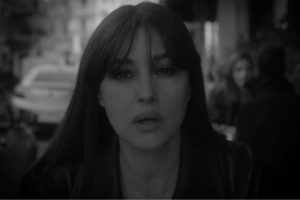
It could be theorized that Audrey is the dreamer, and her dream is the dream, or hallucination, that we have been lost within the entire time. Yet, isn’t it narratively insufficient to conclude that everything is in her head and/or is the sole product of a rape encounter with the Evil Cooper? What about everything that preceded that moment in narrative? It is perhaps enough to view Audrey’s state as metaphorical for a broader state of consciousness. Critically, certain lines of key dialogue that she utters to Charlie (“is this the story of the little girl who lived down the lane? Is it?”) are reiterated, verbatim, by “The Arm” in the “Black Lodge” to Dale Cooper in the Finale of Episode 18. This suggests a tremendous amount about her significance to the overall construct of Twin Peaks.
Following Audrey’s narrative, many clues emerge. For example, the connection between Richard Horne’s parentage comes to fruition in the moments before his electrifying death, and we have enough evidence to presume that, much in the same way as with Diane, Evil Cooper likely preyed upon fear in an effort to gain sexual access to Audrey. Whether that, in and of itself, was capable of de-stabilizing Audrey psychologically in and of itself can only be presumed, because the direct narrative consequences of whatever happened to her, or with her, are never overtly revealed. Thus, though it would seem to be altogether too convenient to necessarily premise the entire Twin Peaks experience from start to finish as being the product of Audrey’s imagination, there is sufficient evidence to suggest that it is the case. Specifically, Audrey’s “dream,” or psychosis, encompasses many of the inherent elements that we have come to associate with Twin Peaks from the outset—i.e., multiple personalities, doppelgangers, the mystery and intrigue of FBI government investigations, conspiracy, sex, prostitution, an astrophysical force that controls our motivations, the disassociation and disaster of family, betrayal, and the shocking horror of an esteemed FBI idol turned rapist.
In my view, there is merit to the interpretation that, within the fabric of Audrey’s dream, there are two central manifestations that are evident from “The Return”: (1) the intoxicating soundtrack and collection of wayward narratives and dialogue that occur at the Roadhouse, as akin to her endless dialogues with Charlie, who is more than likely the embodiment of a therapist; and (2) the dark underbelly of a stark white room, which seems to suggest, in a flash, her real confinement in a psych ward. The split second that we see Audrey in the white room is the brief moment when the entire veneer and fabric of Twin Peaks has been ripped from us, and we have become momentarily privy to the blinding reality beneath it all.

Whatever is “real” and whatever is “imagination” in Twin Peaks is a self-reflexive conundrum—that is, the result of questions whose labyrinthine answers only manage to produce more questions. Though, such is the path of the human consciousness, is it not? As such, I could hypothesize, in her dream, Audrey was raped by Evil Cooper at some point in the past, and that, as a result of the trauma she suffered and the birth of Richard Horne, she has disassociated and is now trapped in a world of sprawling ideations and mythologies borne of psychological confinement – a liminal existence of beauty and terror that is both her reality and her illness.
To that end, her wild and circuitous ramblings about “Billy” could be theorized as nothing more than pointless banter, but, more realistically, they are the desperate figments of a broken mind that is seeking narrative mythology to occupy, define, and in a sense remediate the unresolvable throes of mental illness. Thus, we are made to believe that the exasperated indulgences of her therapist are manifested as the likeness of an intractable, midget accountant—i.e., one whose nettlesome, clinical objective is to assess the whims, needs, and aberrant thought patterns of someone who is mentally ill. After all, this makes sense. In whatever can be theorized as the “real world” in Twin Peaks, we do know that Audrey’s father, Benjamin Horne, has been depicted as a patriarch who is called upon to resolve the woes of his family members with money. It would seem apropos, therefore, that Audrey is left to fend for herself with hired mental health care professionals, rather than with an impatient, and frankly, exhausted father who has excused himself from the morass. He too, we recall, was in the throes of mental illness in Season 2, and his personality crisis imported him into the character of General Robert E. Lee, with his only salvation from the self-imposed “civil war” being his efforts to re-write history and emerge victorious as the commander of the southern forces.
Ultimately, to find narrative cohesion, or “answers,” in such imagery would be to effectively define a narrative that seems, in hindsight, to be a canvas of associations—whether or not they are solely from Audrey’s perspective. The whole world of Twin Peaks has really been, if anything, a deeply complex arena of beauty and madness that has been progressively evolving within the mind of its creators. A journey that is the product of the often complex, and the often banal, courses of the human conscoiusness.
An example of the evolving mythology of the human consciousness takes us back to Season 2. If I were to turn back time and ask David Lynch what he meant by several images and depictions from twenty-five years ago, I might receive an anachronistic response that meant something tangible to him in the early nineties. For example, I return to a particular scene from Season 2, Episode 19, that has resonated with me for twenty-five years. I refer to the scene in which Windom Earle makes his way into Owl Cave, after having surreptitiously followed Cooper, Deputy Andy, Hawk, and Sheriff Truman to the mysterious location. When Deputy Andy accidently fumbles with his axe, and it makes contact with the petroglyph avatar of fire, one of the characteristic diamond symbols in the petroglyph shakes loose, revealing a knob that is oriented in – what would seem to be – its natural position. However, when Windom Earle gains access to Owl Cave, he turns the knob and, in effect, inverts the symbol into the evil symbol that we have been provided all throughout “The Return.” What follows at the tail end of Season Two is Dale Cooper’s journey into the Black Lodge, and a characteristic form of palsy, or shaking, that seems to have afflicted the residents of Twin Peaks. It is as if the natural order has been inverted, and now a characteristic imbalance, or evil, has been unleashed into the world. Yet, of course, this evil was not unleashed for the first time at this moment when Earle turned the handle. It is as old as time itself, or at least has certain elemental underpinnings in the Manhattan Project. Of course, not knowing the answer to Lynch and Frost’s intent in the nineties, I could imagine that a discussion of “good versus evil” would have ensued twenty-five years ago, and that the Black Lodge was a mere foil to the White Lodge, and that in turning the symbol, perhaps access to the inverted evil that is the Black Lodge was made possible at Glastonbury Grove, rather like a portal to great suffering and sorrow.
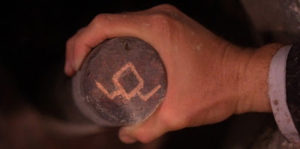
But, as with any narrative, the philosophy of Twin Peaks has had a chance to evolve. The canvas of Twin Peaks has become broader and more complex over the span of twenty-five years, and Lynch’s artistic dabblings into historical notions of “good versus evil” have evolved from mere colorizations of “black” and “white,” and polarizing lodges and waypoints, to complex philosophical imagery that evokes principles of both astrophysics and existentialism. This, of course, leads inexorably to a brief discussion of Episode 8 of “The Return,” which takes us back to 5:29 a.m., on July 16, 1945, and the detonation of the A-bomb as part of the Manhattan Project (cue Penderecki’s “Threnody for the Victims of Hiroshima”). It would be provisional to suggest that Lynch and Frost were somehow suggesting that pure evil was born in this watershed moment of United States history, much like it would be provincial to suggest that Window Earle unleashed evil into the physical universe by turning a handle in a cave. However, these separate occurrences and depictions do seem to suggest that, on some subatomic level, the pure evil that was inherent in the bomb’s theoretical creation managed to uncouple the molecular composition of space-time once it was detonated, resulting in what Gordon Cole and Phillip Jeffries referred to as “Judy.”

The implication that I believe is being conveyed is that the Manhattan Project in Episode 8 caused a “breach,” or rift, to open in the physical universe, which permitted sorrow (“garmonbozia”/creamed corn) to infiltrate the natural world in a new and different way than it has otherwise previously existed. This is rather like the sudden breach, or rift, that we see in a shocking moment of clarity in the Roadhouse when Audrey confronts herself in a stark white mirror. In Episode 8 of “The Return,” upon the unleashing of evil in its raw iteration, we see images of Bob (Frank Silva) enshrouded within the fabric of floating molecules that are being unleashed chaotically through space-time, as if we have been privy to the ill-effects of an atom smashing experiment where Higgs boson “God particles” have been decoupled from the physical universe, causing an irreversible rift in the natural order. This theory bears fruit. In the penultimate episode of “The Return,” our unpredictable English lad Freddie Sykes, with a hand and green glove of superhuman strength, is the only person in the known physical universe who is capable of effectively “atom smashing” the Bob-branded orb of garmonbozia that emerges from Evil Cooper’s corpse, when he is prostrate and slayed in the Twin Peak’s sheriff’s station awaiting imminent, spiritual resuscitation from the Woodsmen.
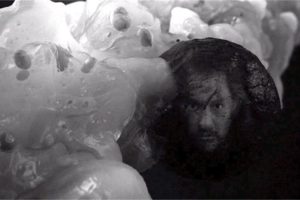
From these images, we see the prophetic metaphors of good and evil and otherwise innocuous foreshadowing images that seem to have an almost dream-like level of inter-connectivity. One of which is Evil Cooper arm-wrestling and displaying an unbeatable level of physical strength, as pitted against the hand of Freddie, who is able to ultimately “atom smash” Bob, and operate as the hand of good that can overcome the hand of evil. Other such images of intractable evil is the depiction of Woodsman inflicting violent havoc in a radio station (“gotta light?”), but more importantly, is the refrain that is repeated:
“This is the water, and this is the well. Drink full, and descend. The horse is the white of the eyes, and dark within.”
As we know from the Fire Walk With Me refrain from seasons past, Lynch typically repeats phrases of particular importance. And this particular statement, uttered during the unmitigated infliction of violence and sorrow, seems to be the origin story of darkness that inhabits Twin Peaks and the mind of the dreamer. The horse, as we recall, is the image that constantly appears to Sarah Palmer when she is otherwise seemingly drunk or overloaded with prescription medications in Seasons 1 and 2. But it is also the same horse, remarkably, that is presented to us in Episode 18 of the Return, when Cooper/Richard finally arrives in Odessa, Texas, to meet Carrie Page/Laura Palmer. A white horse is depicted on her mantle, near the dead corpse of a man shot in the head by a sub-machine gun that lays idly on the floor, as both Carrie/Laura and Cooper/Richard stand by, seemingly disaffected by the trauma.

The next particularly dispositive image of burgeoning evil is the stilted and uncomfortable image of youthful romance, where a young girl (most likely, Sarah Palmer) displays a shy reaction to a boy who attempts to kiss her. As if suggesting that this innocence is akin to some form of fear or vulnerability, the roach or fly that has emerged from the sub-atomic rift manages to crawl to her residence and nest within her body, suggesting that we have perhaps witnessed the inculcation of evil within Sarah Palmer, and the foundation for the ultimate life of sorrow that her daughter will be forced to endure.

It also suggests that Laura was imported into this “world” by the spirits of the Lodge—i.e., the Fireman/giant—in order to somehow either redress, or manifest, the sorrow and grief (see, supra, “garmonbozia”) that exists within the physical universe. Whereas Sarah is the spiritual inhabitor of great sorrow, Laura is the recipient of it, rather like the sacrificial Christ-like figure. However, as we are led to understand, Laura/Carrie is no adequate redemption for pure evil; rather, she is the pre-ordained and sacrificial recipient of sorrow, no matter what the course of her narrative. Either as Laura Palmer, or Carrie Page, suffering seems to find her, and the trappings around her are one in the same: the horse figurine which relate to Sarah Palmer’s visions in the Palmer house, a dead man with his head splattered across the wall, a life on the lam, an underworld of darkness, an undercurrent of pain.
Just as good and evil has evolved over Twin Peaks’ twenty-five year history, so has the notion of self and the consciousness of being. We see, for the first time in “The Return,” the notion that there is not just a good or bad Cooper as was the dual premise in the first two seasons, but rather, there are additional iterations, such as Dougie Jones, or Richard. Thus, ultimately, who “Cooper” is, and what he represents, seems to be a conglomeration of various iterations or schisms of personality: good, bad, cataonic, virile, and an infinite host of others. When the good Dale Cooper finally emerges from his slumber, at the hands of sticking a fork into an electrical socket and then waking up from a coma, his first order of business is to save the physical universe from Evil Cooper. And yet, once that objective is complete, the business of wrapping-up Twin Peaks with a tidy little bow is simply not possible.
For a fleeting moment, we were made to believe that Cooper could somehow crawl back in time through the help of Phillip Jeffries, and avert the murder of Laura Palmer. Through use of interwoven historical footage from Fire Walk With Me, and dimly lit shots of an aged Sheryl Lee reprising her role as Laura as a teenager, Cooper manages to make his way to the precise moment in time before Laura is killed. Yet, this effort is in vain, as Cooper is unable to rescue Laura from her fate of grief, pain, and sorrow. “Fellas, coincidence and fate figure largely in our lives,” Cooper once said almost excitedly in Owl Cave.
Laura is incapable of salvation no matter what her story, and no matter who she is. Whether on a literal time line or plane, or in the fabric of an over-arching dream, one thing remains evident: Cooper has managed to effectively erase the narrative of Twin Peaks: Season 1 and 2 by erasing Laura’s murder at the hands of Bob. But this, of course, does not remediate the ever-existing sorrow that exists in this world. As noble as Cooper is, even he cannot solve that infinite existential dilemma. Nonetheless, in his effort, as he predicted with Diane before he crossed the 430-mile mark in Episode 18, he now presents as a new version of himself—that is, one who is uncertain, vulnerable, and crestfallen to realize that Sarah Palmer does not reside at the house, and that he cannot thread solve the dream-narrative in a manner that can provide spiritual catharsis.

Rather, Ms. Tremond/Chalfont now reside at the Palmer house, which harkens, of course, to the image of Donna Hayward in Fat Trout Trailer Park trailer, encountering lodge spirits in the form of an old woman (“grandmother”) and a young boy (David Lynch’s son), who holds creamed corn (“garmonbozia”) in his hands and makes it disappear like magic. We learn in the final scene of “The Return” that a “Mrs. Chalfont” sold the “Palmer house” to the current residents, The Tremond’s.
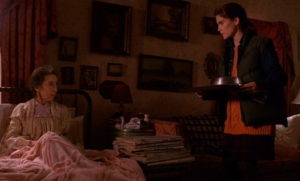
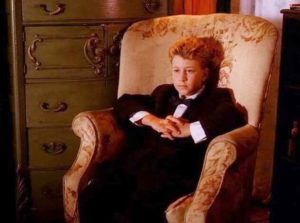
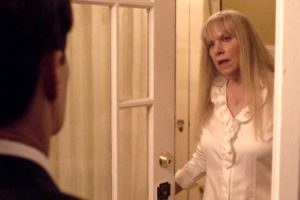
These characters are depicted as spirit beings in Fire Walk With Me as well, and we are left with the distinct impression that though Cooper has perhaps altered the fabric of history in an effort to achieve salvation for himself and Laura, he has left himself inexorably trapped, like Audrey, within a terrible but, at times, beautiful dream of his own manufacture.
198 responses to “Twin Peaks: “The Return” … To The Dream”
tractor supply ivermectin wormer
Twin Peaks: "The Return" … To The Dream
generic vidalista prices
Twin Peaks: "The Return" … To The Dream
does ivermectin work for pinworms
Twin Peaks: "The Return" … To The Dream
international travel with prescription drugs
Twin Peaks: "The Return" … To The Dream
canadian pharmacy online sildenafil
Twin Peaks: "The Return" … To The Dream
buy cheap cialis 20mg online
Twin Peaks: "The Return" … To The Dream
online dr consultation prescription
Twin Peaks: "The Return" … To The Dream
cialis for men
Twin Peaks: "The Return" … To The Dream
ivermectin 6mg
Twin Peaks: "The Return" … To The Dream
cialis used for pulmonary hypertension
Twin Peaks: "The Return" … To The Dream
vidalista without a doctor prescription not scam
Twin Peaks: "The Return" … To The Dream
zinc prophylaxis for coronavirus
Twin Peaks: "The Return" … To The Dream
amoxicillin 30 capsules price
Twin Peaks: "The Return" … To The Dream
azithromycin pills 250 mg
Twin Peaks: "The Return" … To The Dream
best price for viagra 100mg
Twin Peaks: "The Return" … To The Dream
tadalafil without a doctor prescription
Twin Peaks: "The Return" … To The Dream
cialis cheapest price uk
Twin Peaks: "The Return" … To The Dream
viagra from amazon
Twin Peaks: "The Return" … To The Dream
viagra and cialis cadupi
Twin Peaks: "The Return" … To The Dream
viagra without a doctors approval
Twin Peaks: "The Return" … To The Dream
cialis daily dosage
Twin Peaks: "The Return" … To The Dream
tadalafil package insert
Twin Peaks: "The Return" … To The Dream
hydroxychloroquine purchase online
Twin Peaks: "The Return" … To The Dream
is hydroxychloroquine a prophylactic
Twin Peaks: "The Return" … To The Dream
hydroxychloroquine antiviral effects
Twin Peaks: "The Return" … To The Dream
does ivermectin kill pinworms
Twin Peaks: "The Return" … To The Dream
what does prednisone do to your body
Twin Peaks: "The Return" … To The Dream
dapoxetine india brand
Twin Peaks: "The Return" … To The Dream
what is a safe dose of aurogra
Twin Peaks: "The Return" … To The Dream
sildenafil with dapoxetine
Twin Peaks: "The Return" … To The Dream
over the counter cialis walgreens
Twin Peaks: "The Return" … To The Dream
purchase cialis canada
Twin Peaks: "The Return" … To The Dream
cheapest place to buy vidalista
Twin Peaks: "The Return" … To The Dream
cialis canada online pharmacy
Twin Peaks: "The Return" … To The Dream
where can you get cialis over the counter
Twin Peaks: "The Return" … To The Dream
rx tadalafil
Twin Peaks: "The Return" … To The Dream
sublingual sildenafil tablets
sildenafil citrate 100mg research kentucky
do canadian pharmacies need a prescription for cialis?
cialis prescription online
genuine cialis for sale
Twin Peaks: "The Return" … To The Dream
calishite 5e
Twin Peaks: "The Return" … To The Dream
stromectol vs ivermectin paste 1.87
at 210 how many mg of stromectol do i take
cialis 20 mg
cialis 20 mg
cheapest viagra 100mg
cheapest viagra 100mg
levitra plus
how long does levitra last levitra 20 mg
bupropion er
bupropion er
side effects of coreg
side effects of coreg
donepezil 5mg
donepezil 5mg
cephalexin uses
cephalexin uses
clindamycin hcl 300 mg
clindamycin hcl 300 mg
sildenafil fast delivery
sildenafil fast delivery
bimatoprost and latanoprost together
bimatoprost and latanoprost together
clomid for irregular periods
clomid for irregular periods
fluconazole dosing pediatric
fluconazole dosing pediatric
domperidone dose
domperidone dose
[…] buy viagra kamagra online […]
[…] best meds for ed […]
[…] cialis super active cheap […]
[…] play video poker online […]
tadalafil 10mg generic
tadalafil 10mg generic
ivermectin 12mg tablets for human
order stromectol 3 mg
[…] cialis oral jelly 20mg sachets […]
does zithromax treat strep
zithromax for chlamydia
ivermectin usa price
ivermectin 3mg online
Twin Peaks:
https://magazin.leevje.com/2020/05/29/streaming-dienste-fuer-kinder/
Twin Peaks:
http://hydrotercam.com/projects/villa-rustica-renovation/
Twin Peaks:
http://www.smartfuture.com.tr/originelle-monitor-partnersuche-junggeselle-8/
Twin Peaks:
http://www.avvocatotramontano.it/risarcimento-del-danno-da-vacanza-rovinata-tutela-del-turista-deluso/
Twin Peaks:
https://www.leferguson.com/musicalpi-piano-sheet-music-display-first-look/
Twin Peaks:
https://bulli.reisen/category/slowenien/
Twin Peaks:
https://www.doctorparpados.com/orbital-tumor/orbital-tumor5-647×256/
minocycline for acne 100mg
buy minocycline 50mg for humans
buy cialis pills
buy cialis pills
azithromycin 250 price
azithromycin 250 price
Twin Peaks:
http://blogomotesando.lr-group.jp/e175.html
viagra side effects
viagra side effects
cialis 100
cialis 100
walmart cialis
cialis over the counter at walmart
tadalafil 40 mg
tadalafil 40 mg
viagra prescription
viagra prescription
200 mg sildenafil
200 mg sildenafil
buy stromectol online
ivermectin uk
drug albuterol pills
albuterol inhaler mail order
buy ivermectin cream for humans
ivermectin 400 mg brands
tadal
generic cialis daily use
generic viagra us
viagra near me
how does sildenafil work
natural viagra for men
ivermectin 4 tablets price
stromectol for head lice
ivermectin study
where to purchase ivermectin
buy albuterol sulfate nebulizer solution
albuterol 0.083 brand name
flcc.net
flccc alliance
flccc ivermectin
http://www.flccc.net
flccc ivermectin
order ivermectin
ivermectin pills for humans
pyrantel ivermectin
stromectol uk buy
where can i buy ivermectin
cheap stromectol
ivermectin uk buy
stromectol medicine
ivermectin 1
ivermectin virus
ivermectin usa
ivermectin online
generic ivermectin cream
stromectol cvs
buy ivermectin canada
ivermectin topical
buy stromectol uk
purchase ivermectin
ivermectin where to buy
ivermectin uk
ivermectin australia
is ivermectin safe for humans
frontline doctors ivermectin
ivermectin where to buy
cost of ivermectin
purchase ivermectin
stromectol walgreens
ignition casino legal in california
ignition casino usa
ivermectin buy
how to get ivermectin
cialis professional
cialis pills
prednisone 40mg for sale
prednisone 40mg drug
tadalafil otc
tadalafil lilly
generic for tadalafil
buy tadalafil powder
buy provigil europe
provigil generic walgreens
stromectol
stromectol cvs
ivermectin 0.5% brand name
ivermectin gel
cialis viagra sale canada
cheap viagra for sale uk
cialis walmart
cialis australia
buy cheap sildenafil
sildenafil medication
tadalafil 6mg
tadalafil 6mg
furosemide 80 mg
lasix to buy
ivermectina dosis
buy ivermectin canada
cialis rezeptfrei
buy generic cialis online from india
medshuku best place to buy cialis online
best price usa tadalafil
taldenafil
cialis generic
doxazosin and cialis
goodrx tadalafil
sildenafil citrate for sale
sildenafil pills online purchase
generic cialis usa
buy cialis generic india
ivermectin tablets uk
stromectol price in india
sildenafil pills prescription
how to buy sildenafil pills
sildenafil pills online purchase
sildenafil citrate for sale
cialis generic
cheap cialis india
where to buy cialis
generic cialis walgreens price
what does prednisone 20mg look like
purchase prednisone online
prednisone 20mg tablets
prednisone 20mg for sale
maxim peptide tadalafil
purchase cialis online
lagevrio molnupiravir
buy molnupiravir
tadalafil citrate
best tadalafil
tadalafilo
viagra cialis levitra
stromectol kaufen
ivermectin buy
sildenafil citrate for sale
buy viagra from india online
side effects for prednisone
prednisone side effects in women
generic
cheap cialis india
best online real casinos slots
casino games real money
sildenafil citrate
where to order generic viagra
buy generic viagra canada online
sildenafil prices
generic cialis online in uk
tadalafil and dapoxetine
azithromycin 250 mg tablet
how does azithromycin work
borgata rewards log in
the borgata atlantic city
cialis online pharmacy
cialis tablets
what is ivermectin made from
buy ivermectin on line
stromectol price usa
ivermectin solubility
free online casino bonus usa
real money slots
ivermectin for rosacea
doxycycline buy usa
azithromycin ivp
azithromycin ivp
cialis without a doctor prescription
can i buy cialis in mexico
generic for cialis
cialis coupon
cost of viagra generic
chewable viagra
generic cialis
what is cialis
omnicef manufacturer
omnicef manufacturer
iv zithromax
iv zithromax
clindamycin antibiotic
clindamycin antibiotic
ivermectin human dosage
ivermectin wormer
online gambling real money
free money bonus casino
order ivermectin 3mg online
ivermectin 6 mg tablets
ivermectin for human
where to buy ivermectin
iwermektyna
stromectol over the counter
ivermectin 3 mg tablets for human
ivermectin 6mg pills
purchase ivermectin online
buy ivermectin 6mg otc
ivermectin buy
ivermectin for horses
keflex online
keflex online
ivermectin 2ml
ivermectin 50
terramycin
terramycin
augmentin chills
augmentin chills
stromectol 0.1
ivermectin nz
ciprofloxacin dosages
ciprofloxacin dosages
buy ivermectin for humans australia
ivermectin 12mg tablets
ciprofloxacin ribosomal
ciprofloxacin ribosomal
azithromycin elimination
azithromycin elimination
ivermectin lotion cost
ivermectin cost
buy ivermectin 6 mg tablets
order ivermectin 12 mg
ivermectin buy online
stromectol tablets uk
ivermectin tablets for humans for sale
ivermectin cost canada
Twin Peaks:
http://www.nimanshome.co.uk/news/nimans-home-plugs-into-tp-link/
buy ivermectin 3mg tablets
buy ivermectin 3 mg online
Twin Peaks:
http://www.wojtekczyz.de/cms/gastebuch-2/
Twin Peaks:
https://gildedfernfarm.com/musings-on-a-meadow/
Twin Peaks:
http://nukleotyd.pl/2018/04/12/seminarium-o-mniejszych-i-wiekszych-przekretach-w-swiecie-nauki/
Twin Peaks:
http://www.cwen.cm/actualite/10
Twin Peaks:
https://www.bibo.shop/banh-trang-sieu-kay-nha-hang-thuc-an-nhanh-khoan-dung-khoang-chung-la-2-giay-chia-se-cho-thay-di-lien-he-0902430082-hoac-nhan-tin-t/
buy ivermectin nz
stromectol usa
cialis free sample
viagra cialis
Twin Peaks:
https://www.laserenthaarung.at/haarentfernung-zuhause-teil-26-philips-bri863-00-ipl-haarentfernungssystem-lumea-essential-152434/
luckylandslots.com sign in
luckyland slots casino sign in
where to buy ivermectin uk
ivermectin tablets for humans
hydroxychloroquine 200mg tablets
boris johnson hydroxychloroquine
buy ivermectin online
ivermectine vente libre
amazon ivermectina para humanos
online ivermectin
order stromectol online
stromectol xl
Twin Peaks:
https://bimacademy.us/online-learning-apps/